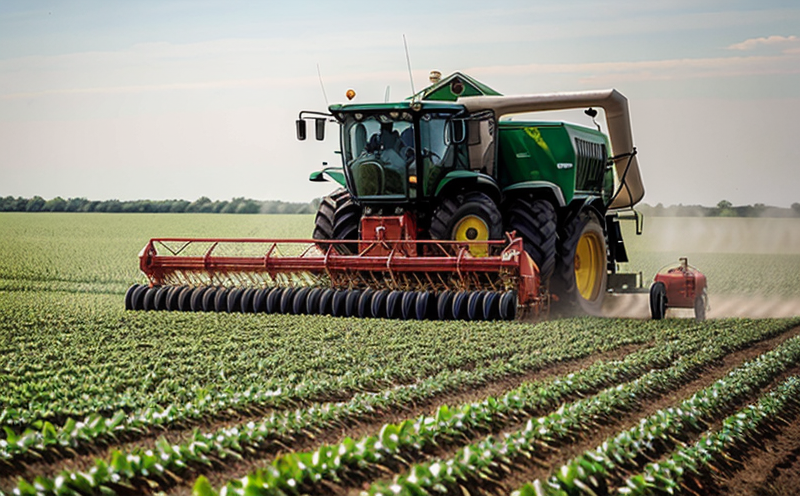Branching Index Testing in Legumes
The Branching Index is a critical parameter in the study of legume plant development, particularly important for understanding the growth patterns and productivity potential. This metric quantifies the number of branches produced by a primary stem or main shoot, which directly impacts crop yield and overall plant health. Legumes like beans, peas, lentils, and chickpeas are crucial crops worldwide due to their nitrogen-fixing abilities and high protein content.
Understanding branching index in legumes is essential for optimizing agricultural practices, improving seed quality, and enhancing productivity. By accurately measuring the branching pattern, breeders can select superior genotypes that exhibit desirable traits such as increased branch formation, which translates into better biomass production and higher grain yield per hectare.
The Branching Index is particularly relevant for legume crops because their growth patterns influence their ability to effectively fix atmospheric nitrogen. This process not only reduces the need for chemical fertilizers but also contributes to soil health through increased biological activity in the root zone. Therefore, optimizing branching can lead to more sustainable agricultural practices.
The testing of the Branching Index involves precise measurement techniques that ensure accurate data collection. This includes using advanced imaging systems and specialized software to count branches on individual plants or plant parts. The primary goal is to provide reliable measurements that reflect actual field conditions, thus supporting informed decision-making in crop management.
The significance of the Branching Index cannot be overstated. It plays a pivotal role in:
Evaluating genetic diversity within legume species,
Identifying high-yielding varieties,
Improving nitrogen fixation efficiency,
Enhancing drought tolerance,
Supporting precision agriculture practices,
Aiding in breeding programs for better crop performance.
The testing process typically involves selecting representative samples from fields or greenhouses, ensuring they are free from disease and stress. Specimens are then prepared using standard protocols to minimize variability while maintaining the integrity of the branching pattern. Imaging technology is employed to capture detailed images that can be analyzed for branch counts.
Accurate measurement tools are crucial in this process. Instruments such as digital cameras, specialized software, and sometimes even 3D scanners may be used depending on the scale and precision required. Reporting standards often follow international guidelines like ISO or ASTM, ensuring consistency across different studies and laboratories.
The Branching Index test results provide valuable insights that can guide various agricultural activities including crop selection, breeding programs, and sustainable farming practices. By focusing on optimizing branching patterns, farmers and researchers alike contribute to more efficient resource use and increased productivity in legume crops.
Benefits
Aids in selecting high-yielding varieties of legumes,
Enhances nitrogen fixation efficiency,
Improves drought resistance,
Sustains soil health through increased biological activity,
Supports precision agriculture practices,
Facilitates breeding programs for better crop performance.
The Branching Index Testing service offers significant advantages to stakeholders in the agricultural and forestry sectors. It enables more accurate assessments of plant health, productivity, and sustainability. By providing precise data on branching patterns, this testing ensures that decisions are based on solid evidence rather than guesswork.
This service also contributes to reducing environmental impact by promoting sustainable farming practices. With better understanding of how branching affects nitrogen fixation and water use efficiency, farmers can make informed choices about planting densities and irrigation schedules. This leads to more efficient resource utilization and healthier ecosystems.
Eurolab Advantages
At Eurolab, we pride ourselves on delivering unparalleled quality and accuracy in our Branching Index Testing. Our experienced team uses state-of-the-art equipment and follows stringent protocols to ensure reliable results. Here are some of the key advantages:
Accurate measurements using advanced imaging systems,
Strict adherence to international standards like ISO and ASTM,
Precision in sample preparation and handling,
Detailed reporting with comprehensive data analysis,
Support for both research and commercial applications,
Compliance with regulatory requirements.
We understand the importance of trustworthiness in agricultural testing. Our commitment to quality is reflected not only in our methodology but also in our dedication to continuous improvement. Eurolab ensures that all tests are conducted under controlled conditions, minimizing external variables and enhancing reliability.
Use Cases and Application Examples
| Use Case | Description |
|---|---|
Crop Selection |
Determine the best varieties for specific environmental conditions. |
Breeding Programs |
Identify genetic traits that enhance branching and yield potential. |
Precision Agriculture |
Optimize planting density and irrigation schedules based on branch distribution patterns. |
Nitrogen Fixation Efficiency |
Evaluate the effectiveness of different legume varieties in fixing atmospheric nitrogen. |
Sustainable Farming Practices |
Support environmentally friendly farming methods through enhanced resource use efficiency. |
Drought Resistance |
Identify legume species that can thrive under water stress conditions. |
The Branching Index Testing is particularly useful in various agricultural and forestry applications. For instance, in crop selection, this test helps identify varieties with superior branching patterns which are likely to produce higher yields. In breeding programs, it aids in selecting genotypes that exhibit desirable traits related to increased branch formation.
In precision agriculture, the Branching Index testing can be used to optimize planting densities and irrigation schedules by providing detailed information on how different varieties perform under various conditions. This ensures more efficient use of water and nutrients, leading to better crop yields.
The test is also valuable in evaluating nitrogen fixation efficiency among legume species. By comparing the branching patterns of different varieties, researchers can determine which ones are most effective at fixing atmospheric nitrogen. Additionally, this testing supports sustainable farming practices by helping farmers make informed decisions that minimize environmental impact while maximizing productivity.





